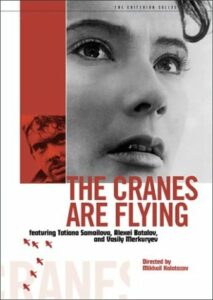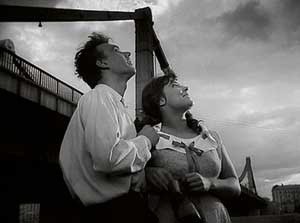“The Cranes Are Flying” – a Poetic Masterpiece of Russian Cinema

Title:”The Cranes Are Flying”
Release Date: 1957
Director: Michaił Kałatozow
Cast: Aleksiej Batałow, Tatiana Samojłowa, Wasilij Mierkuriew, Swietłana Charitonova, Aleksandr Szworin
It was the only Soviet film to be awarded the Palme d’Or at Cannes. The work of Mikhail Kalatozov enchanted critics with its poetic lyricism, moving plot and demythologization of war.
“The Cranes Are Flying” is a film that could have been made in Soviet cinema only during the thaw, i.e. after Joseph Stalin’s death and Nikita Khrushchev’s condemnation of Stalinism. It was then, after 1956, that Soviet art departed from the nightmarish assumptions of socialist realism. Artists were finally able to explore topics that had been forbidden or hypocritical until then, such as the history of World War II. Mikhail Kalatozov showed this very theme in his painting, and he did it in a masterful way. In the foreground there is a touching story about love, and in the background there is the tragedy of war events.
“The Cranes Are Flying” – unfaithful Veronica
The main plot of “The Cranes Are Flying” revolves around the story of a young girl Veronika (played by the phenomenal Tatiana Samoylova) who dreams of an imminent wedding with her beloved Boris (Alexei Batalov), but instead of an engagement ring receives a message that the man is leaving for the front. Carefree and romantic love in one moment is put to a dramatic test. The heroine cannot even say goodbye to her fiancé, because she is late for the place from which the soldiers are marching.

Soon it turns out that the news about Boris dies, and the life of a young girl becomes more and more difficult. In a bombing raid the heroine loses her parents and her home, and then falls into apathy. After moving in with Boris’ family, during one of the bombings, the terrified Veronika succumbs to Mark (Aleksandr Shvorin), Boris’ half-brother, who is in love with her. Eventually she agrees to marry him and together they go to Siberia, where she treats wounded soldiers. Unfortunately, it turns out that her husband is a dishonest coward who uses bribery to avoid conscription. Soon there is also an eyewitness to Boris’ death. Despite this, Veronika hopes to the end that her beloved is still alive and goes to the train station on the day the soldiers return from the front.
The film “The Cranes Are Flying” exposes above all the moral aspect of the protagonist’s behavior. Veronika cannot forgive herself for her own weakness, and her family and environment constantly stigmatize her. The girl who did not wait for the soldier deserves the highest condemnation in the opinion of society. Veronica’s drama is intensified by the fact that she sincerely loves Boris. However, the viewer’s sympathy remains with the girl. It is also hard not to notice that Boris is not quite right with his beloved, as he volunteers to join the army and only informs her a few hours before his departure.
Veronica’s unfaithfulness gains justification primarily in her difficult wartime fate. She is an extremely human character and thus dramatic in her authenticity. She feels longing, fear of loneliness and fear for the future. Her suffering has an existential dimension, exposing the drama of choices faced by every human being. It consists mainly in the necessity of accepting the fact that life, contrary to expectations, turns out the way it does. As a history teacher who met Veronica in Siberia says to her – “Such is the human fate that one has to forget a lot”.

“The Cranes Are Flying” – the lyricism of Kalatozov’s picture
“The Cranes Are Flying” is an unusually lyrical film whose expressive power lies in its emotional poeticism. It is born, above all, out of a masterful use of imagery. In the film we have to do with many symbols that replace the literalness of the events. These include the film’s most important motif – the key of cranes in the sky – the opening and closing sequence. The flight of the birds, as well as a recurring poem in the film, symbolize the realm of dreams about a better world and love. The scene of Boris’s death, on the other hand, is represented by the image of the fading sun and the whirling trees.
Also of symbolic significance are Veronica’s white, ethereal dress and the flowers we see in the final scenes. They bring to mind the protagonists’ would-be wedding and echo Boris’ vision from the moment of his death, when he sees his beloved in her bridal dress.
“The Cranes Are Flying” – war stripped of its glory
The greatness of “The Flying Cranes” lies also in the fact that the director clearly demythologizes war events, which in the Soviet Union had an eminently political overtone. It must be remembered that the Soviet victory over fascism was the founding myth of postwar communism in the entire Eastern European bloc. It was additionally strengthened by the symbolism of the victorious revolution, which was to bring about the final triumph of the proletariat. Kalatozov, meanwhile, shows World War II not from the perspective of great battles, but through the lens of ordinary people for whom war is always a personal tragedy. It brings only death, poverty, hunger and destruction of dreams of a happy life.
A.Grabicz, J. Klinowski,”Kino, wehikuł magiczny. Przewodnik osiągnięć filmu fabularnego. Podróż druga 1950 – 1959″, Kraków 1987.
“Kino klasyczne”, pod red. T. Lubelskiego, I. Swoińska, R. Syska, Kraków 2011.
